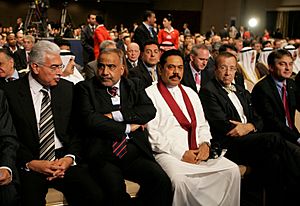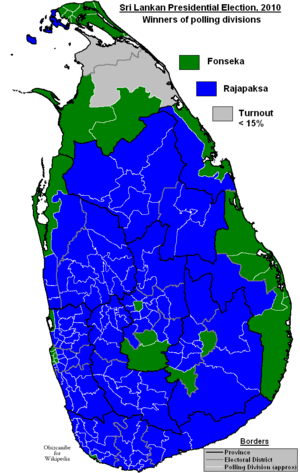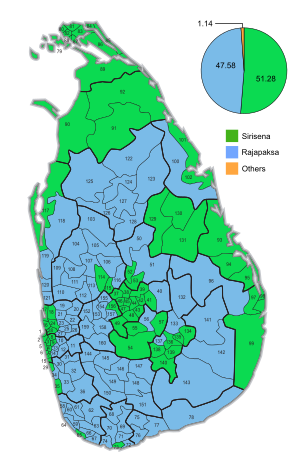Mahinda Rajapaksa facts for kids
Quick facts for kids
Mahinda Rajapaksa
|
|||||||||||||||||||||||||||||||||||||||||||||||||||||||||||||||||||||||||||||||||
|---|---|---|---|---|---|---|---|---|---|---|---|---|---|---|---|---|---|---|---|---|---|---|---|---|---|---|---|---|---|---|---|---|---|---|---|---|---|---|---|---|---|---|---|---|---|---|---|---|---|---|---|---|---|---|---|---|---|---|---|---|---|---|---|---|---|---|---|---|---|---|---|---|---|---|---|---|---|---|---|---|---|
| මහින්ද රාජපක්ෂ மஹிந்த ராஜபக்ஷ |
|||||||||||||||||||||||||||||||||||||||||||||||||||||||||||||||||||||||||||||||||
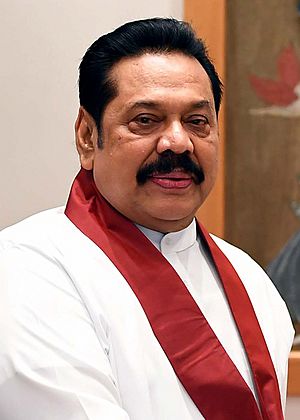
Rajapaksa in 2018
|
|||||||||||||||||||||||||||||||||||||||||||||||||||||||||||||||||||||||||||||||||
| 6th President of Sri Lanka | |||||||||||||||||||||||||||||||||||||||||||||||||||||||||||||||||||||||||||||||||
| In office 19 November 2005 – 9 January 2015 |
|||||||||||||||||||||||||||||||||||||||||||||||||||||||||||||||||||||||||||||||||
| Prime Minister | Ratnasiri Wickremanayake D. M. Jayaratne |
||||||||||||||||||||||||||||||||||||||||||||||||||||||||||||||||||||||||||||||||
| Preceded by | Chandrika Kumaratunga | ||||||||||||||||||||||||||||||||||||||||||||||||||||||||||||||||||||||||||||||||
| Succeeded by | Maithripala Sirisena | ||||||||||||||||||||||||||||||||||||||||||||||||||||||||||||||||||||||||||||||||
| 13th Prime Minister of Sri Lanka | |||||||||||||||||||||||||||||||||||||||||||||||||||||||||||||||||||||||||||||||||
| In office 21 November 2019 – 9 May 2022 |
|||||||||||||||||||||||||||||||||||||||||||||||||||||||||||||||||||||||||||||||||
| President | Gotabaya Rajapaksa | ||||||||||||||||||||||||||||||||||||||||||||||||||||||||||||||||||||||||||||||||
| Preceded by | Ranil Wickremesinghe | ||||||||||||||||||||||||||||||||||||||||||||||||||||||||||||||||||||||||||||||||
| Succeeded by | Ranil Wickremesinghe | ||||||||||||||||||||||||||||||||||||||||||||||||||||||||||||||||||||||||||||||||
| In office 26 October 2018 – 15 December 2018 |
|||||||||||||||||||||||||||||||||||||||||||||||||||||||||||||||||||||||||||||||||
| President | Maithripala Sirisena | ||||||||||||||||||||||||||||||||||||||||||||||||||||||||||||||||||||||||||||||||
| Preceded by | Ranil Wickremesinghe | ||||||||||||||||||||||||||||||||||||||||||||||||||||||||||||||||||||||||||||||||
| Succeeded by | Ranil Wickremesinghe | ||||||||||||||||||||||||||||||||||||||||||||||||||||||||||||||||||||||||||||||||
| In office 6 April 2004 – 19 November 2005 |
|||||||||||||||||||||||||||||||||||||||||||||||||||||||||||||||||||||||||||||||||
| President | Chandrika Kumaratunga | ||||||||||||||||||||||||||||||||||||||||||||||||||||||||||||||||||||||||||||||||
| Preceded by | Ranil Wickremesinghe | ||||||||||||||||||||||||||||||||||||||||||||||||||||||||||||||||||||||||||||||||
| Succeeded by | Ratnasiri Wickremanayake | ||||||||||||||||||||||||||||||||||||||||||||||||||||||||||||||||||||||||||||||||
| 12th Leader of the Opposition | |||||||||||||||||||||||||||||||||||||||||||||||||||||||||||||||||||||||||||||||||
| In office 18 December 2018 – 21 November 2019 |
|||||||||||||||||||||||||||||||||||||||||||||||||||||||||||||||||||||||||||||||||
| President | Maithripala Sirisena | ||||||||||||||||||||||||||||||||||||||||||||||||||||||||||||||||||||||||||||||||
| Prime Minister | Ranil Wickremesinghe | ||||||||||||||||||||||||||||||||||||||||||||||||||||||||||||||||||||||||||||||||
| Preceded by | R. Sampanthan | ||||||||||||||||||||||||||||||||||||||||||||||||||||||||||||||||||||||||||||||||
| Succeeded by | Sajith Premadasa | ||||||||||||||||||||||||||||||||||||||||||||||||||||||||||||||||||||||||||||||||
| In office 6 February 2002 – 2 April 2004 |
|||||||||||||||||||||||||||||||||||||||||||||||||||||||||||||||||||||||||||||||||
| President | Chandrika Kumaratunga | ||||||||||||||||||||||||||||||||||||||||||||||||||||||||||||||||||||||||||||||||
| Prime Minister | Ranil Wickremesinghe | ||||||||||||||||||||||||||||||||||||||||||||||||||||||||||||||||||||||||||||||||
| Preceded by | Ratnasiri Wickremanayake | ||||||||||||||||||||||||||||||||||||||||||||||||||||||||||||||||||||||||||||||||
| Succeeded by | Ranil Wickremesinghe | ||||||||||||||||||||||||||||||||||||||||||||||||||||||||||||||||||||||||||||||||
|
|||||||||||||||||||||||||||||||||||||||||||||||||||||||||||||||||||||||||||||||||
|
|||||||||||||||||||||||||||||||||||||||||||||||||||||||||||||||||||||||||||||||||
| Personal details | |||||||||||||||||||||||||||||||||||||||||||||||||||||||||||||||||||||||||||||||||
| Born |
Percy Mahendra Rajapaksa
18 November 1945 Weeraketiya, Southern Province, British Ceylon (now Sri Lanka) |
||||||||||||||||||||||||||||||||||||||||||||||||||||||||||||||||||||||||||||||||
| Political party | Sri Lanka Podujana Peramuna (after 2018) | ||||||||||||||||||||||||||||||||||||||||||||||||||||||||||||||||||||||||||||||||
| Other political affiliations |
Sri Lanka Freedom Party (before 2018) | ||||||||||||||||||||||||||||||||||||||||||||||||||||||||||||||||||||||||||||||||
| Spouses | Shiranthi Rajapaksa (née Wickremesinghe) |
||||||||||||||||||||||||||||||||||||||||||||||||||||||||||||||||||||||||||||||||
| Children | Namal Yoshitha Rohitha |
||||||||||||||||||||||||||||||||||||||||||||||||||||||||||||||||||||||||||||||||
| Relatives |
|
||||||||||||||||||||||||||||||||||||||||||||||||||||||||||||||||||||||||||||||||
| Residences | Carlton House, Tangalle Medamulana Walawwa |
||||||||||||||||||||||||||||||||||||||||||||||||||||||||||||||||||||||||||||||||
| Alma mater | Sri Lanka Law College | ||||||||||||||||||||||||||||||||||||||||||||||||||||||||||||||||||||||||||||||||
| Profession | Attorney | ||||||||||||||||||||||||||||||||||||||||||||||||||||||||||||||||||||||||||||||||
| Website | Official website: http://www.mahindarajapaksa.lk | ||||||||||||||||||||||||||||||||||||||||||||||||||||||||||||||||||||||||||||||||
Mahinda Rajapaksa (born Percy Mahendra Rajapaksa on 18 November 1945) is a well-known Sri Lankan politician. He served as the sixth President of Sri Lanka from 2005 to 2015. He also held the position of Prime Minister of Sri Lanka several times: from 2004 to 2005, in 2018, and from 2019 to 2022.
Rajapaksa also served as the Leader of the Opposition from 2002 to 2004 and again from 2018 to 2019. He was also the Minister of Finance from 2005 to 2015 and from 2019 to 2021. He is a lawyer by profession.
He was first elected to the Parliament of Sri Lanka in 1970. He led the Sri Lanka Freedom Party from 2005 to 2015. Rajapaksa became president in November 2005 and was re-elected in 2010 for a second term. He left office in January 2015 after losing his bid for a third term.
In October 2018, President Maithripala Sirisena appointed Rajapaksa as prime minister. This led to a political disagreement, and Rajapaksa resigned in December 2018. He then became the Leader of the Opposition. In 2019, he became the leader of the Sri Lanka Podujana Peramuna party. He was appointed prime minister again in November 2019 by his brother, Gotabaya Rajapaksa, who had become president.
In May 2022, there were large protests in Sri Lanka. People were unhappy with the government and the country's economic situation. Protesters called for Rajapaksa's resignation. On 9 May 2022, Mahinda Rajapaksa resigned as prime minister.
Contents
Early Life and Education
Mahinda Rajapaksa was born in 1945. He was the third child of D. A. Rajapaksa and Dandina Samarasinghe Dissanayake. His family lived in Medamulana.
When he was six, he went to Richmond College in Galle. Later, his family moved to Colombo. Mahinda Rajapaksa attended Nalanda College, Colombo and then Thurstan College. At Thurstan College, he played sports like cricket and rugby. He was also a shot put champion.
In the mid-1960s, he started working as a library assistant. He became involved in left-wing politics. In 1968, he was appointed as an organizer for the Sri Lanka Freedom Party (SLFP) in Beliatta.
Political Journey
Starting in Parliament
In 1970, Rajapaksa ran for election in the Beliatta area. He won and became a Member of Parliament (MP) at 24 years old. This made him the youngest MP at that time. While serving as an MP, he also studied law at Sri Lanka Law College.
In 1977, he lost his parliamentary seat in the general elections.
Working as a Lawyer
In November 1977, Rajapaksa became an attorney at law. He then worked as a criminal lawyer in Tangalle until 1994.
Returning to Parliament
Rajapaksa was re-elected to parliament in 1989. He represented the Hambantota District. He became known for his work with the Mothers' Front. This group helped mothers whose children had "disappeared" during a difficult time in the country.
He spoke about the importance of human rights. He asked foreign countries to consider human rights when giving aid to Sri Lanka.
Becoming a Cabinet Minister
In 1994, the People's Alliance party won the election. Rajapaksa was appointed Minister of Labor. In 1997, he became the Minister of Fisheries and Aquatic Resources.
Leading the Opposition
In 2001, the United National Party won the elections. Rajapaksa lost his government position. However, in March 2002, he was appointed as the Leader of the Opposition.
First Time as Prime Minister
After the 2004 parliamentary elections, Rajapaksa became the new prime minister. He was sworn in on 6 April 2004. As prime minister, he also managed the Ministry of Highways, Ports & Shipping.
Presidency (2005–2015)
First Term as President
| Mahinda Rajapaksa first term cabinet 10 most senior members |
||
|---|---|---|
| Office | Name | Term |
| Prime Minister | Ratnasiri Wickremanayake | 2005–2010 |
| D. M. Jayaratne | 2010-2010 | |
| Minister of Foreign Affairs | Mangala Samaraweera | 2005–2007 |
| Rohitha Bogollagama | 2007–2010 | |
| G. L. Peiris | 2010-2010 | |
| Minister of Defence | Himself | 2005–2010 |
| Minister of Finance | Himself | 2005–2010 |
| Minister of Justice | Amarasiri Dodangoda* | 2005–2009 |
| Milinda Moragoda | 2009–2010 | |
| Athauda Seneviratne | 2010-2010 | |
| Minister of Home Affairs | Sarath Amunugama | 2005–2007 |
| Karu Jayasuriya | 2007–2008 | |
| Sarath Amunugama | 2009–2010 | |
| John Seneviratne | 2010-2010 | |
| Minister of Industry and Commerce | Sarath Amunugama* | 2005–2007 |
| Kumara Welgama | 2007–2010 | |
| Risad Badhiutheen | 2010-2010 | |
| Minister of Healthcare and Nutrition | Nimal Siripala de Silva* | 2005–2010 |
| Maithripala Sirisena | 2010-2010 | |
| Minister of Education | Susil Premajayantha | 2005–2010 |
| Bandula Gunawardane | 2010-2010 | |
| Minister of Agriculture | Maithripala Sirisena | 2005–2010 |
| Mahinda Yapa Abeywardena | 2010-2010 | |
| *Retained from previous administration | ||
Mahinda Rajapaksa was chosen by the Sri Lanka Freedom Party to run for president in 2005. He won the election on 17 November 2005. He became the President of Sri Lanka.
After becoming president, Rajapaksa also took on the roles of Minister of Defense and Minister of Finance. He worked with the military leaders to end the Sri Lankan Civil War. The government declared victory in May 2009.
Second Term as President
| Mahinda Rajapaksa Second term cabinet 10 most senior members |
||
|---|---|---|
| Office | Name | Term |
| Prime Minister | D. M. Jayaratne* | 2010–2015 |
| Minister of Foreign Affairs | G. L. Peiris* | 2010–2015 |
| Minister of Defence | Himself* | 2010–2015 |
| Minister of Finance | Himself* | 2010–2015 |
| Minister of Justice | Rauff Hakeem | 2010–2015 |
| Minister of Home Affairs | John Seneviratne* | 2010–2015 |
| Minister of Industry and Commerce | Risad Badhiutheen* | 2010–2015 |
| Minister of Health | Maithripala Sirisena* | 2010–2014 |
| Tissa Attanayake | 2014–2015 | |
| Minister of Education | Bandula Gunawardane* | 2010–2015 |
| Minister of Agriculture | Mahinda Yapa Abeywardena* | 2010–2015 |
| *Retained from previous administration | ||
After the civil war ended, Rajapaksa was re-elected president in 2010. During his second term, he started many large building projects. These included the Colombo Lotus Tower, Magampura Mahinda Rajapaksa Port, and the Mattala Rajapaksa International Airport.
Sri Lanka also saw improvements in its Human Development Index during this time. There were new highways, roads, and efforts to make Colombo more beautiful. The country experienced economic growth.
In November 2014, Rajapaksa announced he would seek re-election for a third term.
2015 Presidential Election
In the 2015 presidential election, Rajapaksa ran against Maithripala Sirisena. Sirisena had been a minister in Rajapaksa's government. Several political parties and former government members supported Sirisena.
Rajapaksa released his plan, called Mahinda's Vision — The World Winning Path. He promised to create a new constitution. He also pledged to set up special forces to fight crime.
In the election on 8 January 2015, Rajapaksa was defeated by Maithripala Sirisena. He won 47.6% of the votes.
After the Presidency
Prime Ministerial Candidacy in 2015
After losing the presidency, Rajapaksa tried to become prime minister in the 2015 parliamentary elections. He was elected as a Member of Parliament for Kurunegala. However, his party lost the election to Ranil Wickremesinghe's party. Wickremesinghe became prime minister.
Return to Legislature
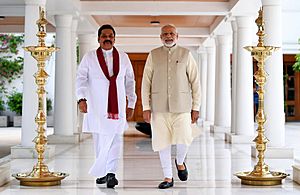
Rajapaksa returned to Parliament as an MP for Kurunegala District. This made him the first former president to serve as an MP after his presidency.
In 2016, supporters of Rajapaksa formed a new party called the Sri Lanka Podujana Peramuna (SLPP). Although he was not officially its leader, he was a key figure.
2018 Local Election
Rajapaksa's new party, the Sri Lanka Podujana Peramuna (SLPP), won many local elections in 2018. They secured control of 239 out of 340 local government bodies. This success led the SLPP to ask for new general elections.
2018 Political Changes
In October 2018, President Maithripala Sirisena appointed Rajapaksa as prime minister again. The previous prime minister, Ranil Wickremesinghe, did not accept this. This led to a political disagreement.
Parliament held votes of no-confidence against Rajapaksa. In December 2018, a court ruled that his cabinet could not function. Rajapaksa resigned as prime minister on 15 December 2018. Wickremesinghe was re-appointed prime minister. Rajapaksa then became the Leader of the Opposition.
Third Time as Prime Minister (2019–2022)
The Rajapaksa family gained power again in the 2019 presidential election. His younger brother, Gotabaya Rajapaksa, won and became the new president. In August 2020, the SLPP won a large victory in parliamentary elections. Mahinda Rajapaksa was sworn in as prime minister for the fourth time.
In 2022, there were widespread protests in Sri Lanka. People were upset about the country's economic situation. Protesters called for the Rajapaksa family to resign. On 9 May 2022, Mahinda Rajapaksa resigned from his post as prime minister. He and his family moved to a navy base for safety.
2024 Elections and Retirement
In the 2024 presidential election, Mahinda Rajapaksa's son, Namal Rajapaksa, ran for president but did not win. After this, Mahinda Rajapaksa decided not to run for re-election in the 2024 parliamentary elections. This marked the end of his 54-year political career.
Personal Life and Family
Mahinda Rajapaksa was born into a well-known political family in Weeraketiya. His father, D. A. Rajapaksa, was also a Member of Parliament. Mahinda Rajapaksa often wore a special earthy brown shawl, like his uncle, to represent the people of his area.
Many members of Rajapaksa's family are involved in politics. His brother, Gotabaya Rajapaksa, was the former president of Sri Lanka. Another brother, Basil Rajapaksa, served as Minister of Economic Development and later Minister of Finance. His eldest brother, Chamal Rajapaksa, was also an MP and served as the Speaker of Parliament.
In 1983, Rajapaksa married Shiranthi Wickremesinghe, who is a child psychologist. They have three sons: Namal, Yoshitha, and Rohitha. Namal Rajapaksa has also been elected as a Member of Parliament.
Mahinda Rajapaksa is known for being superstitious. He wears special charms and consults astrologers for advice. He is also known for collecting many valuable rings, which has earned him the nickname "lord of the rings."
Honours
 2014: Star of Palestine
2014: Star of Palestine- Nalanda Keerthi Sri award in 2004 from his old school, Nalanda College.
- 3 honorary doctorates:
- A Doctor of Law from the University of Colombo in 2009.
- An honorary doctorate from the Peoples' Friendship University of Russia in 2010 for his work towards world peace.
- An honorary doctorate from the Beijing University of Foreign Languages in China in 2011.
- The Visva Bharati University in India gave him the title Professor Emeritus.
See also
 In Spanish: Mahinda Rajapaksa para niños
In Spanish: Mahinda Rajapaksa para niños
- List of political families in Sri Lanka
- Mahinda Rajapaksa cabinet


